


Piasecki-PV2 - $$4.95
The PV-2 first flew on April 11, 1943. Developed as a technology demonstrator, the PV-2 brought several new features such as the first dynamically balanced rotor blades, a rigid tail rotor with a tension-torsion pitch change system, and a full cyclic and collective rotor pitch control.
Frank Piasecki's first Helicopter-the PV-2
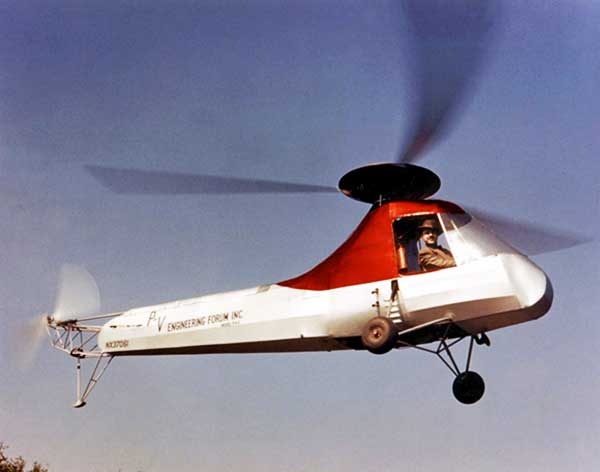
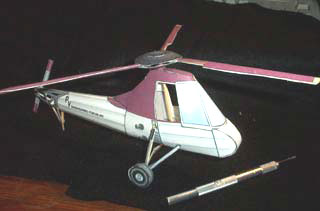
This
model of the Piasecki PV-2 part of a Helicopter Appreciation Collection
(HAP)
of important early experimental Helicopters.
Frank Piasecki was the holder of of the first Helicopter Pilot's License. He formed the PV Engineering Forum in 1943 to develop practical rotor craft.
His first successful design was this experimental PV-2 single seater with a 90 HP Franklin flat-four engine driving a three blade main rotor. Piasecki himself was the pilot for the first flight which was made on April 11, 1943.
I really like the auto-gyros and early helicopters! I don't know why, but they are very appealing to look at and model. I guess it's the contraption-ish nature of these machines. All the biplanes and jets start to look alike after awhile, but each of these creatures is a work of art! Gives me (yet another) reason to re-up my subscription when it comes due! Neil Linnell
The Piasecki PV-2 Experimental Helicopter
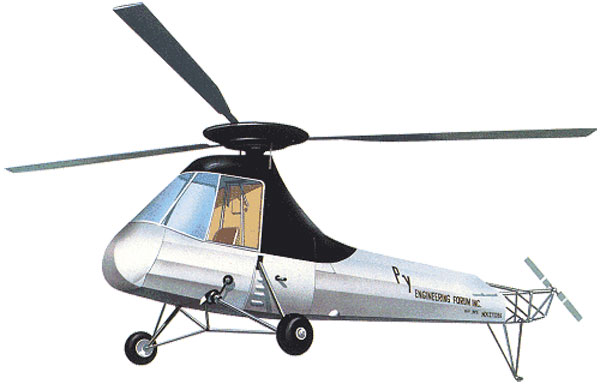
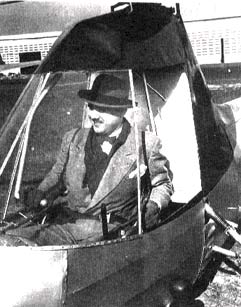 When Igor Sikorsky began to publicly demonstrate his VS-300
helicopter in 1941, he called it the automobile of the future.
This idea quickly captured the public imagination and enthusiastic
helicopter designers stepped forward to produce the next aerial
version of the Model T. On April 11, 1943, Frank Piasecki became
the second American to successfully fly a helicopter of his own
design, the Piasecki-Venzie PV-2. He built it with far fewer resources
than Sikorsky had available to construct the VS-300, yet the PV-2
flew with an unprecedented smoothness and stability. Ironically,
Frank Piasecki intended his first helicopter design to be the
forerunner of a revolution in personal transportation, but his
company actually evolved into one of the foremost manufacturers
of large cargo helicopters sold primarily to the military.
When Igor Sikorsky began to publicly demonstrate his VS-300
helicopter in 1941, he called it the automobile of the future.
This idea quickly captured the public imagination and enthusiastic
helicopter designers stepped forward to produce the next aerial
version of the Model T. On April 11, 1943, Frank Piasecki became
the second American to successfully fly a helicopter of his own
design, the Piasecki-Venzie PV-2. He built it with far fewer resources
than Sikorsky had available to construct the VS-300, yet the PV-2
flew with an unprecedented smoothness and stability. Ironically,
Frank Piasecki intended his first helicopter design to be the
forerunner of a revolution in personal transportation, but his
company actually evolved into one of the foremost manufacturers
of large cargo helicopters sold primarily to the military.
Piasecki started early in the helicopter industry when he joined the Platt-LePage Aircraft Company in 1940 as an engineer working on the XR-1 (see NASM collection). At the same time, he started a small consulting firm with Harold Venzie called the Piasecki-Venzie Engineering Forum. Venzie and Piasecki had studied engineering together at the University of Pennsylvania.
The company's first helicopter effort, the PV-1, did not advance beyond the drawing board. This design employed ducted-air to counteract the torque produced by the main rotor. Although advanced, safer and potentially more efficient than a conventional tail rotor, the concept went beyond what was possible with available technology and Piasecki began to lay out a new design equipped with single main and tail rotors.
Piasecki soon left Platt-LePage in disgust over their haphazard approach to engineering and began to concentrate all his efforts on the P-V Engineering Forum's new single main and tail rotor model, designated the PV-2. This aircraft was only a small single-seat demonstrator.
Piasecki and the P-V team hoped it would lead to a production personal transport sold to individual customers, or generate contracts for other models. While the small team of engineers focused on the design, finding actual components with little money and acute wartime shortages required expert scrounging.
The group obtained a discarded Curtiss-Wright CW-1 Junior (see NASM collection) fuselage airframe and they found many of the engine accessories and transmission components in automotive dealerships or junkyards. Piasecki also enlisted the students at local engineering schools to draft blueprints - at no cost to the company. One area where Piasecki could not cut corners was the engine.
It had to be compact, lightweight, and still provide sufficient power. The only suitable model that the company found was a 90 horsepower Franklin. The engineers mounted the motor vertically but it was not designed to operate in this position and the lubrications system required some modification.
The transmission consisted almost entirely of junked automobile parts but the rotor blades were masterpieces of new engineering that contributed much to the ultimate success of the PV-2. At PV Engineering, Elliot Da land was a respected and experienced engineer who had also worked on the XR-1 at Platt-LePage. He oversaw construction of the three main rotor blades used on the PV-2. Daland designed and built each blade using many of the components found in a conventional airplane wing. This method followed standard practice in the helicopter industry. He used steel tubing for the main spar, solid spruce formed the leading edge, and the ribs consisted of pieces of birch plywood cut, glued, and nailed together. After final adjustments, workmen covered the rotor blades with fabric.
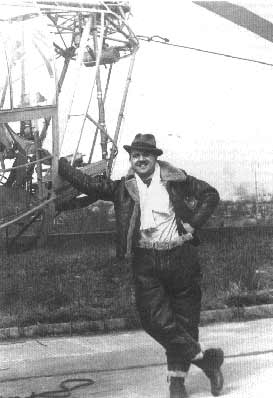 Daland's most
important innovation was incorporating adjustable trim weights
on these blades to allow easy dynamic balancing. Sikorsky had
discovered the value in blades that weighed the same to minimize
destructive vibration, but Piasecki first realized that the blades
on a helicopter must have the same Centers of Gravity. Daland
devised a relatively easy way to do this.
Daland's most
important innovation was incorporating adjustable trim weights
on these blades to allow easy dynamic balancing. Sikorsky had
discovered the value in blades that weighed the same to minimize
destructive vibration, but Piasecki first realized that the blades
on a helicopter must have the same Centers of Gravity. Daland
devised a relatively easy way to do this.
He would balance the blades dynamically by hanging the blade from its root end and swinging it like a pendulum. Workmen then added or removed trim weights until the set of PV-2 blades swung the same way in frequency and amplitude. Sikorsky only balanced his early production helicopter blades statically, on the assembly line, but this did not cure chronic vibration.
The PV Engineering Forum introduced another innovation to reduce rotor vibration. Engineers built the blades so that the Center-of-Gravity fell at a point forward of the Center-of-Lift. By using this arrangement, any abrupt blade deflections caused by sudden turbulence forced the blade leading edge to pivot into the wind gust. This reaction worked to stabilize the blade and further reduce vibration.
In a nod to the citizen pilot, PV Engineering ingeniously designed two of the blades to fold back over the tail. This feature allowed a pilot to stow the helicopter in a standard garage, or even tow it behind his car. Once the construction phase was complete, the entire aircraft was painted silver with maroon trim and lettering, official colors of the University of Pennsylvania.
The PV-2 first flew by accident. A frayed clothesline tethering the aircraft safely to the ground suddenly snapped and the helicopter became airborne. Frank Piasecki was at the controls and managed to safely land, despite his complete lack of previous flight experience in helicopters. He had only fourteen hours of flight time in fixed-wing aircraft.
This brush with disaster did not deter the plucky pioneer and Piasecki remained the chief test pilot for the PV-2, in addition to his duties as chief engineer and company president. At that time, the company was not generating any income and it had not attracted any financial backing so the financial situation was dire. The PV-2 was PV Engineering's most valuable asset and the firm handled it with extreme care, flying only as necessary for testing.
To generate business, Piasecki decided to try capitalizing on wartime military contracts. A breakthrough came on October 20, 1943, when he flew the aircraft before a large crowd of military officials and government onlookers at Washington's National Airport. The Navy showed particular interest in Piasecki's demonstration. The service had come under Congressional scrutiny for largely ignoring helicopter developments generated by Army Air Force (AAF) investment and Navy leaders were looking for a company that could cater to their specialized needs.
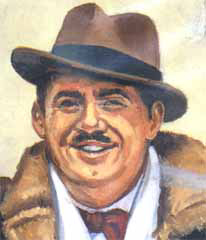 The Navy had purchased and toyed
with several Sikorsky models, but these failed to meet fleet demands
for a helicopter that could carry heavy sonar gear or pick up
crewmen stranded at sea. Sikorsky was stretched to the limit trying
to meet AAF orders, but the PV Engineering Forum could give full
attention to Navy requirements. They were also the only other
U. S. company to demonstrate a practical helicopter up to that
time.
The Navy had purchased and toyed
with several Sikorsky models, but these failed to meet fleet demands
for a helicopter that could carry heavy sonar gear or pick up
crewmen stranded at sea. Sikorsky was stretched to the limit trying
to meet AAF orders, but the PV Engineering Forum could give full
attention to Navy requirements. They were also the only other
U. S. company to demonstrate a practical helicopter up to that
time.
Piasecki convinced Navy leaders to fund his proposal to build and fly a prototype that featured two main rotors mounted in tandem. This large machine could perform rescue work or conduct anti-submarine warfare (ASW) using heavy sonar gear. PV designated the aircraft the PV-3, but it was later known as the X-HRPX Dogship (see NASM collection). The Dogship attracted several outside investors and led to a production contract to build the HRP-1.
Forty years after the world's first powered airplane flight by the Wright Brothers, Philadelphia engineer Frank Piasecki made aviation history on April 11, 1943, with the second successful American helicopter to fly, his PV-2 model, now on display at the American Helicopter Museum in West Chester. Helicopters had long been thought impossibly difficult and impractical by most airplane manufacturers, leaving the field open to intrepid entrepreneurs like Piasecki and Igor Sikorsky, a Russian-born engineer in Bridgeport, Connecticut who piloted the first successful flight in 1939.
A native of West Philadelphia, Frank Nicholas Piasecki was born in 1919 and grew up making model airplanes, fascinated with this exciting new industrial technology. Attending Franklin Institute conferences on Rotating Wing Aircraft in 1938 and 1939 helped inspire him to study aeronautical engineering at the University of Pennsylvania, where he met other eager students, including Harold Venzie. In 1940, the two young men established the P-V (Piasecki-Venzie) Engineering Forum, an informal evening study team to decide what to design and build with their team's growing talent and expertise. From this small beginning was to come the Piasecki Helicopter Corporation, operating in Delaware County.
By the end of 1940 Piasecki had joined the Platt-LePage Company as assistant to the designer Elliot Daland; Daland was nearly blind, and Piasecki served as his "eyes." The Platt-LePage plant lay next to the General Steel Castings Foundry, which later became the Boeing-Vertol assembly plant on Route 29 1. In 1943 Frank Piasecki was managing his own company, P-V Engineering Forum, after the departure of his partner; his successful design of the PV-2 became clear when Frank himself learned to fly it, after only twelve hours of airplane piloting experience.
After his first flight in April of 1943, he took the
new model to Washington, D. C., and demonstrated the machine's
precise fingertip control characteristics. Wartime needs brought
a Coast Guard contract in January 1944. The Navy had been slow
to realize the potential of the helicopter, but at the urging
of Congressman Harry S. Truman finally agreed to this contract
for development of a large anti-submarine helicopter. Piasecki's
group responded with their large tandem rotor model XHRP-X, affectionately
dubbed the "Flying Banana."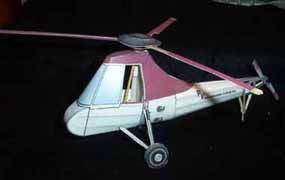
Government contracts made the young manufacturing company attractive to investors, and soon a public stock offering transformed the P-V Company onto the Piasecki Helicopter Corporation, with 51 percent of the stock held by Rockefeller Associates and Felix Du Pont. After Frank Piasecki left in 1955, as a result of a bitter proxy fight, the company was reorganized as the Vertol Aircraft Corporation. In 1960 the Boeing Airplane Company acquired Vertol, and soon built anew expanded plant in Ridley Township.
Boeing's helicopter division has continued to lead in development and production of large transport helicopters. Over the past decade Boeing has diversified into smaller attack helicopters and the revolutionary tilt rotor V/STOL (Vertical/Short Take-Off and Landing) aircraft, the V-22, designed originally for troop transport. Going his own way, Frank Piasecki has received numerous awards and honors for his role in American aviation, and since 1955 has been president of the Piasecki Aircraft Corporation of Essington, a Delaware County firm engaged in research on new VTOL aircraft designs.
The Practical Rotor
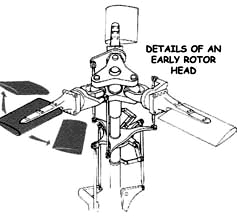 The basic problem
with any rotor supported aircraft, in any condition other than
when it is hovering in still air, is the tendency of the different
amounts of lift generated by the advancing and retreating blades
of the rotor to roll the aircraft. In an aircraft moving forwards,
it is clear that the effective speed of the airflow over the advancing
blade is its own rotational speed plus the forward speed of the
aircraft, whereas that over the retreating blade is its own rotational
speed minus the forward speed of the aircraft. The blade with
the higher airflow speed will generate more lift than the other
blade, and this difference will tend to roll the rotor disc and
in turn the whole aircraft.
The basic problem
with any rotor supported aircraft, in any condition other than
when it is hovering in still air, is the tendency of the different
amounts of lift generated by the advancing and retreating blades
of the rotor to roll the aircraft. In an aircraft moving forwards,
it is clear that the effective speed of the airflow over the advancing
blade is its own rotational speed plus the forward speed of the
aircraft, whereas that over the retreating blade is its own rotational
speed minus the forward speed of the aircraft. The blade with
the higher airflow speed will generate more lift than the other
blade, and this difference will tend to roll the rotor disc and
in turn the whole aircraft.
The optimum solution to the problem is shown in the diagram (below right). This involves the articulation of the rotor blades from hinges on the central shaft. The vertical hinge allows the blade to move backward and forward, while the horizontal hinge permits the blade to move up and down. The forward and backward movement of the blades is useful, but not essential, to adequate control of the rotor disc. The advancing blade can swing back slightly as the speed of the airflow increases, while the retreating blade can move forward slightly; these two movements help to reduce the speed differential between the blades.
Far more important, however, is the freedom of the blade to hinge up and down on the horizontal hinge. For as the relative airspeed of the advancing blade increases and more lift is developed, the hinge allows the blade to rise; this reduces the apparent angle of incidence of the blade and so moderates the amount of lift generated. On the other side of the rotor disc, exactly the opposite happens: as the relative airspeed of the retreating blade falls, less lift is generated than previously, and the blade falls on its hinge; this increases the apparent angle of incidence.
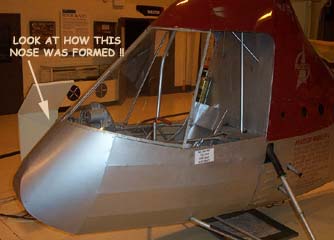 |
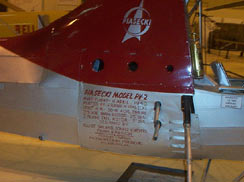 These are photos of the Piasecki PV-2 which is on exhibit a the International Helicopter Museum located in Pennsylvania. |
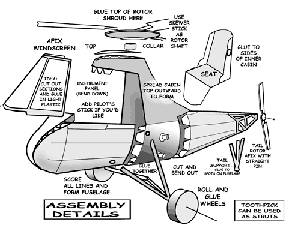
Assembly Tips
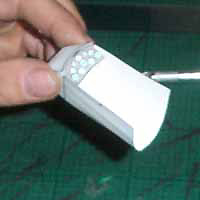 The front strip comes up, is glued to the little tabs & the instrument panel gets folded over |
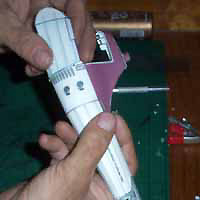 Carefully affix the nose with a slight upward tilt.. Press the glued tabs for a good grip |
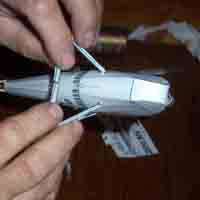 Skewer sticks (large version) and toothpicks (regular version) are needed to stiffen the LG |
 Hot melt glue is great for attaching the landing gear.. Just bend it into configuration |
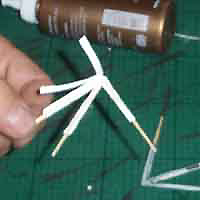 From all the photos of this helicopter, it looks like the supports meet in the middle like this |
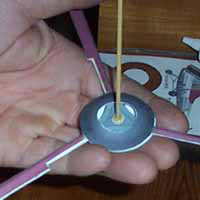 Again, hot melt glue the rotor shaft holding it till it cools to get it nice and perpendicular |
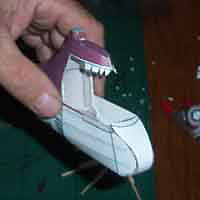 The Seat makes up easily and is glued to the sides of the cockpit for added strength |
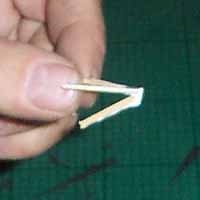 Tail support. Fool around with it till you get the ends to match the glue alignment spots |
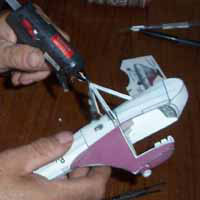 Hot melt the roll up wheels to the landing gear for quick and strong results |
It shouldn't be hard to install an electric motor in this little
puppy..
Specifications for the Piasecki PV-2 Helicopter
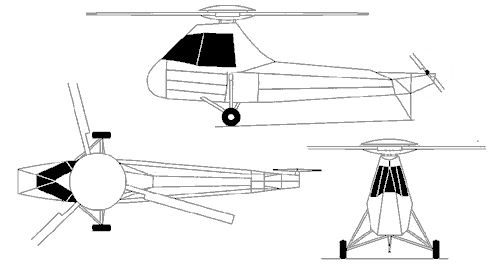 |
Length: 21 ft 6 in fuselage Rotor diameter: 25 ft Disc area: 78.5 ft² Max takeoff weight: 1,000 lb Powerplant: 1× Franklin Engine Company 4 cyl. air-cooled piston, 90 hp Performance Maximum speed: 100 mph Ferry range: 150 mi |


